Executive summary
The Theme Advisory Group (TAG) is an independent and multidisciplinary group established in the second half of 2021 to advise on and propose a shortlist of new themes for future euro banknotes. Its members were appointed by the European Central Bank (ECB) based on proposals from euro area national central banks. The Group considered 29 themes in total – based on members’ own ideas and the public’s input – which were evaluated against certain criteria. The 29 themes considered, and the criteria used, are described in the report.
There was a broad consensus among TAG members that they should try to avoid suggesting motifs or narratives that draw too heavily upon any one national culture. Members also felt that themes should avoid the gender biases inherent in many representations of Europe’s past. There was a strong overall preference for imagery that could connect the banknotes to a dynamic Europe of people and nature over any undue emphasis on institutions or static symbols of the past. TAG members hoped to be able to propose themes that could convey a strong sense of shared European values while at the same time resonating powerfully with European citizens. Equally, TAG members, while highly conscious of the importance of contemporary events, acknowledged the need for the banknotes to be relevant and recognisable to those who will use them in decades to come.
A shortlist of six themes was produced following an internal voting procedure. The themes were ranked as follows, with the full support of the Group.
“European values mirrored in nature”
Description
The six banknotes feature the six values of the European Union as defined in the Treaty of Lisbon: human dignity, freedom, democracy, equality, rule of law, and human rights. We will use visual imagery to convey a seventh value: our connection to, and respect for, our environment and the natural world.
Story
Europe is not only a living place, it is also an idea. And the EU is not just an organisation, but also a set of values.
We bring these values together with nature as components of the same underlying ethos. We reaffirm the role of European values as the building blocks of a Europe of the people, by the people, for the people. Sustainability and environmental preservation are then incorporated as a further fundamental value. These are European values, naturally.
Advantages
- The two key ideas of this theme – European values and nature – were two of the most popular themes proposed in the focus groups.
- European values are inclusive of all nations and people in Europe. The theme is timeless and transcends all borders.
Disadvantages
- Given that values are somewhat abstract concepts, the success of this theme will greatly depend on the design chosen to represent the values. At the same time, representing these abstract yet extremely important concepts on the banknotes is quite a magical thing.
“Birds: free, resilient and inspiring”
Description
This theme is inspired by the EU Birds Directive, which aims to protect all of the 500 wild bird species in the EU. The Directive is one of the oldest pieces of EU legislation on the environment and exemplifies the shared responsibility and cooperation of the EU’s 27 Member States. It also reminds us of the need to share our continent with all life forms that sustain our common existence. These birds are real and vivid in themselves and also a symbol of our collective identity.
Story
Birds have always lived near humans, and by closely observing their appearance and behaviour over the centuries, we have learned a lot about the environment and ourselves.
Birds do not care about national borders so they have always symbolised freedom and aspiration. Their nests remind us of our own desire to build places and societies where we can nurture the future. In their songs we hear our own appreciation of free and beautiful expression. When they return with their seasonal migration, we feel hope. They enrich the world without depleting it – as we should too.
Advantages
- This theme has a strong European dimension and a bold message for sustainability.
- It creates an emotional connection and is legible, inclusive and timeless.
- It lends itself to a visually pleasing and memorable design.
- It reveals the diversity of Europe’s nature, landscapes and seasons.
Disadvantages
- Some people do not like or are afraid of birds (ornithophobia).
- Some other countries have birds on their banknotes.
“The future is yours”
Description
This theme creates “portraits” of Europeans of the future. The bearers of these banknotes are the bearers of the collective imagination in which people create their own, as yet undefined, possibilities.
This theme shows the boundless potential of Europeans and the dream to be portrayed on the banknote one day.
Story
The ideas and innovations that will determine Europe’s future lie deep within every European. Europe is shaped by your thoughts, your dreams, your skills and your inventions. The future is yours.
Advantages
- It highlights innovation, ideas and new perspectives for Europe.
- It connects the past to the present and the future.
- It is inclusive and emotive.
Disadvantages
- It could be seen as a theme for younger people.
- It is very abstract.
“Rivers: the waters of life in Europe”
Description
This theme combines the public’s strong desire for banknotes that celebrate the natural wonders of Europe with a broader message about interconnectedness and sustainability.
Story
Europe’s rivers cross borders. They connect us to each other and to nature. They remind us of the deep sources of our common life and also represent the flow and flux of a dynamic, ever-changing continent. They nurture us and we must nurture them in return.
Advantages
- This proposal includes the values that we share and should protect, but the theme is not abstract.
- Rivers cross borders freely.
- Rivers connect and facilitate trade.
- Preserving nature is one of the most important goals of Europe and Europeans.
- Timeless and natural beauty.
Disadvantages
- No emotional connection.
- Not strictly a European theme.
“Hands: together we build Europe”
Description
This theme creates a physical and easily understood representation of the six core values of the EU: human dignity, freedom, democracy, equality, rule of law and human rights. It also takes inspiration from the motto of the European Union: “United in diversity”. The human hand – familiar to us all but never the same in any two people – is used to make these abstract ideas feel more immediate and human.
Story
“Hands: together we build Europe” uses a universal language to celebrate diversity and unity. It represents everyone who has shaped Europe through our shared EU values. Hands have built Europe – its physical infrastructure, its artistic heritage, its literature, and its many other features. Hands build, weave, heal, teach, guide, and so much more. Hands tell tales of labour, age and relationships. They also share stories of heritage, history and culture. It is time to celebrate the hands that have built Europe and continue to do so every day.
Advantages
- Gives a sense of unity and togetherness.
- Easy to visualise.
- A story focused on people rather than countries.
- Timeless: hands as expressers of human emotion.
- It is very strong on emotive connectivity, since hands are the tool of human touch.
Disadvantages
- The symbols could be misinterpreted. (A good design is therefore crucial. Some research into anthropological aspects would also be helpful to avoid any embarrassing misunderstanding across cultures.)
- Citizens connect much more easily with nature, animals and people, although this issue can be addressed through a good design. The theme does not exclude the possibility of incorporating these aspects and, of course, hands belong to people.
- Some similarities with Swiss franc banknotes, although they tell different stories.
“Our Europe, ourselves”
Description
We each have our own story. We each create our own identity. But we also share a common identity as Europeans. We grow as individuals but also as part of a community, through our relationships with each other.
This theme indicates the freedom, the values and openness of people in Europe.
Story
The banknotes represent the individual and collective lives of the people who inhabit Europe through six different dimensions: being, doing, thinking, loving, communicating, and living. These are the ways in which we connect our inner selves to the outer world, the private to the public, self to society, the physical body to the symbolic realm.
Advantages
- It focuses on the individual within the framework of Europe.
- It opens the idea of European identity to everybody (within Europe and in the wider world).
- It focuses on individuality and on the symbolic understanding of being and togetherness.
Disadvantages
- Potential misunderstanding of the word “identity”.
- Very abstract.
1 Introduction
As part of its plans to redesign euro banknotes, on 6 December 2021 the European Central Bank (ECB) announced the launch of the process for selecting new themes and designs for future euro banknotes.
Once the design process has been completed, the Governing Council will authorise the production of new euro banknotes and decide on potential issuance dates. It can take several years for new banknotes to be developed, issued and put into circulation.
The theme and design process consists of two consecutive main steps.
- Step 1: Theme selection – establish a list of eligible themes and select the one(s) that will be used in the design contest.
- Step 2: Selection of designs – establish a list of possible motifs and organise a design contest.
This document focuses on the first step and, more specifically, on the work of the Theme Advisory Group (TAG), an independent and multidisciplinary group established in the second half of 2021 to advise on and propose a shortlist of new themes for future euro banknotes. The TAG has three objectives:
- review and take into account the findings from the qualitative research on future themes for euro banknotes, which was conducted via focus groups between December 2021 and March 2022;
- draw up a shortlist of potential themes and associated motifs, ranked in order of preference;
- draft a brief story for each of the themes on the final shortlist.
Once the TAG has made its proposals, the ECB will consult the public on their preferred themes from the shortlist.
To support the first step of the theme and design process, the ECB commissioned the market research company Ipsos to carry out qualitative research to find out the European public’s views and preferences with regard to the theme of future euro banknotes[1]. The research was conducted via online focus groups in all 19 euro area countries plus Croatia and Bulgaria. The purpose of the research was twofold: (i) to understand the public’s preferences as to the theme of future euro banknotes, with a view to producing a list of preferred themes and associated motifs; and (ii) to understand public perceptions of the common design elements[2] of the current Europa series of banknotes as well as possible new common design elements, again with the aim of drawing up a list of preferred common design elements.
2 Establishing the Theme Advisory Group
The TAG was established in the second half of 2021 in order to consider possible new themes for the future euro banknotes. The group comprises an eclectic mix of independent high-level experts drawn from diverse fields such as the history, natural and social sciences, the visual arts and technology and representing all the countries in the euro area.
Once the Governing Council had approved the process for developing new themes and designs, the ECB asked each national central bank in the euro area to nominate a maximum of three candidates to represent their country in the TAG. The ECB assessed all nominees and a final list of 19 members – representing each euro area country – was submitted to the ECB’s Executive Board and to the Governing Council for approval. Malta and Estonia had to replace their respective nominees with new candidates early on in the process as the original candidates withdrew for personal reasons. At a later stage in the process the TAG members representing Portugal and Belgium stepped down owing to incompatible professional commitments. Because the TAG’s work was already at an advanced stage, it was not considered appropriate to launch a process to select new nominees.
The final composition of the TAG (including three ECB representatives, who do not have voting rights) was as follows:
- Lisa Borgenheimer (Germany), Professor of Information Design, HfG Offenbach am Main
- Toomas Kiho (Estonia), Editor-in-chief, Akadeemia
- Fintan O’Toole (Ireland), Professor in Irish Letters, Princeton University, and columnist at The Irish Times
- Costas Varotsos (Greece), Artist and Professor, Faculty of Architecture, Aristotle University of Thessaloniki
- Nuria Oliver (Spain), Director and Co-founder, ELLIS Alicante Unit, and Chief Data Scientist, DataPop Alliance
- Stéphane Distinguin (France), Founder and CEO, Fabernovel
- Fabio Beltram (Italy), Professor of Physics of Matter, Scuola Normale Superiore, Pisa
- Demetrios Michaelides (Cyprus), Professor Emeritus of Classical Archaeology, University of Cyprus
- Ieva Zībārte (Latvia), Head of Exhibitions, Zuzeum Art Centre
- Marija Marcelionytė-Paliukė (Lithuania), Professor, Vilnius Academy of Arts
- Patrick Sanavia (Luxembourg), Director, Luxembourg National Heritage Office
- Emanuel Buttigieg (Malta), Associate Professor in Early Modern History, Department of History, Faculty of Arts, University of Malta
- Alice Twemlow (Netherlands), Professor of History, Theory and Sociology of Graphic Design and Visual Culture, University of Amsterdam
- Peter Aufreiter (Austria), General Director and Scientific Managing Director, Vienna Museum of Science and Technology
- Jana Arbeiter (Slovenia), Assistant Professor and Researcher, Faculty of Social Sciences, University of Ljubljana
- Silvia Miháliková (Slovakia), Professor and researcher, Slovak Academy of Sciences, Institute for Sociology, Trnava University
- Maaria Wirkkala (Finland), Artist
- Ton Roos (ECB), Chair, Directorate Banknotes, European Central Bank
- Paloma Varela (ECB), Secretary, Directorate Banknotes, European Central Bank
- Esther Tejedor (ECB), Observer, Directorate General Communications (replaced in May 2022 by Georgina Garriga), European Central Bank
Members from Portugal and Belgium who withdrew from the process:
- Stephan Vanfleteren (Belgium), Photographer
- Elvira Maria Correia Fortunato (Portugal), Vice-Rector, NOVA University of Lisbon
3 The work of the Theme Advisory Group
The TAG held nine meetings between 9 December 2021 and 7 July 2022, both virtually and in hybrid format. To facilitate the Group’s work, TAG members were given some background information on the world of banknotes, the redesign process and similar redesign projects carried out by other central banks.
The Group was tasked with drawing up a shortlist of themes and associated motifs for future euro banknotes and to draft a story for each of the shortlisted themes. Members took into account the findings from the qualitative research on future themes. Each member was asked to draft two proposals for a theme: one based on their own ideas and one based on the input received from the public via the qualitative study conducted by Ipsos.
At the start of the process the TAG agreed on the criteria to be used in selecting the themes. After exchanging views and familiarising themselves with the criteria used in selecting the theme for the first series of euro banknotes, the TAG members identified seven criteria and classified them as either essential, main or desirable.
The Group also decided on the ranking method that they would use to produce a shortlist of themes ranked in order of preference. The TAG agreed that they would use an anonymous two-round voting system to obtain the final shortlist.
4 Theme criteria
The TAG agreed on seven criteria – which were classified as essential, main or desirable – and assessed all of the proposed themes against them. All of the themes met the essential criteria.
Essential criteria
- European: the theme should symbolise Europe, carry a message of European unity and integration and represent European citizens and European values. Chief among these values are democracy and the equal dignity of all people.
- Inclusive: the theme should transcend any set of meanings specific to any one Member State or to any one historic, cultural or gender identity. It should speak to people of all ages and backgrounds.
Main criteria
- Human/emotive: the theme should be inspiring, animate and able to connect with people’s feelings, experiences and lives in a positive way.
- Acceptable: the theme should inspire the greatest possible degree of assent and enthusiasm from the general public.
- Legible: illustrations of the theme should strike a balance between being legible and understandable by everybody and being able to demonstrate a certain level of depth and complexity.
Desirable criteria
- Attractive: the theme should facilitate the portrayal of artistically accomplished and aesthetically pleasing design features with an appealing story and motifs.
- Timeless: the theme should not be affected by the passing of time or reflect contemporary events that might not be topical in the future.
5 Voting and ranking process
The TAG agreed that a two-round online voting system would be used to arrive at a final shortlist.
The first round of voting was conducted anonymously online. TAG members were not allowed to vote for their own proposals. During this round, the TAG assessed the 29 proposed themes against the previously defined criteria (essential, main and desirable). If a theme was not considered to be European or inclusive, it was assigned a score of zero and eliminated from the selection process. Themes that met the essential criteria were awarded a score from 1 to 5 (with 5 being the highest) for each of the main and desirable criteria. Therefore, the maximum possible score a theme could receive was 25, and the minimum was zero.
Members voted on the 29 themes, and the Group agreed to review the ten highest ranked themes, also with a view to merging similar proposals. This resulted in a shortlist of six themes, which were then put through to a second round of voting.
The second round of voting was conducted using the paired comparison method, whereby the themes were compared against each other and the difference in importance assigned a value from 0 to 3. This second round of voting resulted in the final shortlist of six ranked themes.
6 Theme proposals
It was decided that each TAG member would propose two themes – one based on their own ideas and one based on input from the public – and that they would assess their proposals against the previously defined criteria (essential, main and desirable). During the process some members decided to submit just one theme proposal. Each member presented their proposal(s) to the group in the meetings held on 21 April 2022 and 12 May 2022. These presentations were followed by extensive discussions.
The Group proposed 29 themes in total, which generally reflected the broader theme proposals suggested by the public in the qualitative research.
There was a broad consensus among TAG members that they should try to avoid suggesting motifs or narratives that draw too heavily upon on any one national culture
Members felt that themes should avoid the gender biases inherent in many representations of Europe’s past. There was a strong overall preference for imagery that could connect the banknotes to a dynamic Europe of people and nature over any undue emphasis on institutions or static symbols of the past. TAG members hoped to be able to propose themes that could convey a strong sense of shared European values while at the same time resonating powerfully with European citizens. Equally, TAG members, while highly conscious of the importance of contemporary events, acknowledged the need for the banknotes to be relevant and recognisable to those who will use them in decades to come. The theme should be forward-looking while reflecting contemporary perspectives and dimensions.
Many TAG members were of the view that EU or European values should be captured in the bank notes in some way. The discussions revealed different ideas, such as EU values, EU institutions, key figures in the history of the EU, and EU symbols. In the end, most proposals appeared to be grounded in, or draw inspiration from, the concept of EU values and how the theme could foster a better understanding of EU values today while also linking the ideals of Europe’s ancient past to its bright future.
The Group also considered how themes could reference the climate crisis and biodiversity loss – as one of the biggest challenges facing Europeans – or a future with diverse European communities and people crossing borders.
6.1 The TAG’s final theme proposals
Below is the final shortlist of themes proposed by the TAG, ranked in order of preference.
6.1.1 “European values mirrored in nature”
Description
The six banknotes feature the six values of the European Union as defined in the Treaty of Lisbon: human dignity, freedom, democracy, equality, rule of law and human rights. We also use visual imagery to convey a seventh value: our connection to, and respect for, our environment and the natural world.
Story
Europe is not only a living place, it is also an idea. And the EU is not just an organisation, but also a set of values.
We bring these values together with nature as aspects of the same underlying ethos. We reaffirm the role of European values as the building blocks of a Europe of the people, by the people, for the people. Sustainability and environmental preservation are then incorporated as a further fundamental value. These are European values, naturally.
Potential motifs
The six banknotes align nicely with the six core values of Europe. So each euro banknote represents one European value illustrated with different natural scenes on the front and other more human/planet-centric motifs on the back.
€5: Freedom
Front: animals – birds flying freely in the sky.
Back: humans – a human-based depiction of the value of freedom, such as a person or a group of people moving freely, dancing or running.
€10: Human dignity
Front: mountain landscape – a mountain range or a majestic mountain.
Back: humans – a baby’s hand holding or touching an older hand.
€20: Democracy
Front: coastal landscape – a seascape with a beach. Every grain of sand and every drop of water matter, just as every European citizen counts.
Back: humans/monuments – democracy through the lens of monuments, with a depiction of the hemicycle of the European Parliament building in Brussels, juxtaposed with a hand voting or a group of people raising their hands as a symbol of democracy.
€50: Equality
Front: forest landscape – forest scene with trees. The trees appear equal, yet they are different and contribute equally to the forest.
Back: humans/science and education – equality is depicted through the lens of science and education, with a particular emphasis on healthcare, for example a physician treating a patient while surrounded by students or the hand of healing and concern extended to all.
€100: Rule of law
Front: river landscape – a river on its inexorable path towards the sea, flowing within its banks, free but controlled and channelled.
Back: humans – an image of justice, either the traditional motif of blind justice with the scales or a more representative image of justice.
€200: Human rights
Front: flower landscape – diverse flowers, each different, each beautiful, each precious, represent diverse societies which together form a beautiful bouquet. Human rights are necessary for a society to blossom.
Back: humans and environment – motifs related to human and environmental diversity with an emphasis on the green transition and climate change. This banknote (the highest-value banknote in the series) will emphasise diversity between people and between our ecosystems as necessary pillars for a healthy and blooming society and planet.
Advantages
- The two key ideas in this theme – European values and nature – were two of the most popular themes proposed in the focus groups.
- European values are inclusive of all nations and people in Europe. The theme is timeless and transcends all borders.
Disadvantages
- Given that values are somewhat abstract concepts, the success of this theme will greatly depend on the design chosen to represent the values. At the same time representing these abstract yet extremely important concepts on the banknotes is quite a beautiful thing.
6.1.2 “Birds: free, resilient and inspiring”
Description
This theme is inspired by the EU Birds Directive, which aims to protect all of the 500 wild bird species in the EU. The Directive is one of the oldest pieces of EU legislation on the environment and exemplifies the shared responsibility and cooperation of the EU’s 27 Member. It also reminds us of the need to share our continent with all the life forms that sustain our common existence. These birds are real and vivid in themselves and also a symbol of our collective identity.
Story
Birds have always lived near humans, and by closely observing their appearance and behaviour over the centuries, we have learned a lot about the environment and ourselves.
Birds do not care about national borders so they have always symbolised freedom and aspiration. Their nests remind us of our own desire to build places and societies where we can nurture the future. In their songs we hear our own appreciation of free and beautiful expression. When they return with their seasonal migration, we feel hope. They enrich the world without depleting it – as we should too.
Potential motifs
Each banknote takes its imagery from a particular European bird. Each bird represents a season of the year and a type of European landscape and human activity. The birds mentioned below are for illustrative purposes only.
€5: Skylark
Seen in many European cultures as the harbinger of spring. On the banknote it is accompanied by the landscapes it inhabits: the farms and fields of agricultural life, exemplifying the value of day-to-day work.
€10: Cuckoo
The sound of our summers, the voice of our forests, hills and lush, blooming landscapes. They personify happiness and joy.
€20: Tern
A bird of the water and seascapes. It is a migrant, covering vast distances but also returning to the same colony to hatch its eggs. It stands for community and family values.
€50: Owl
A bird of winter which has long been a symbol of wisdom. It stands for Europe’s living heritage of learning, science and reflection, and reminds us that our progress cannot come at the expense of the natural world.
€100: Stork
A bird of autumn and of villages, towns and cities. Their nests – on our chimneys and spires – remind us of how we can coexist with nature, giving it a place to be reborn and receive joy. This bird represents a link between folk wisdom and the modern world.
€200: Hoopoe and/or roller
These species are in rapid decline and will disappear from Europe if we do not act to protect them. The images on the banknotes should inspire preservation. They give us both a warning of what will happen if we do not move to a sustainable future and the hope that we can do so.
Advantages
- This theme has a strong European dimension and a bold message for sustainability.
- It makes an emotional connection and is legible, inclusive and timeless.
- It lends itself to a visually pleasing and memorable design.
- It reveals the diversity of Europe’s nature, landscapes and seasons.
Disadvantages
- Some people do not like or are afraid of birds (ornithophobia).
- Some other countries have birds on their banknotes.
6.1.3 “The future is yours”
Description
This theme creates “portraits” of Europeans of the future. The bearers of these banknotes are the bearers of the collective imagination in which people create their own, as yet undefined, possibilities.
This theme shows the boundless potential of Europeans and the dream to be portrayed on the banknote one day.
Story
The ideas and innovations that will shape the future of Europe lie deep within every European. Europe is shaped in your thoughts, your dreams, your skills and your inventions. The future is yours.
Potential motifs
Every banknote has a placeholder for a “future portrait”, such as whitespace, an outline or a reflective surface. On one side, the motifs are symbolically represented through historical and/or current tools, methods and objects. On the other side, we see the future visions of the “future person” (you, the bearer of the note). Everybody can see themselves on the banknote in their future job or area of expertise.
€5: Education and knowledge
Philosophy, writing and research.
€10: Art
Painting, cinema, theatre, music, dance and architecture.
€20: Science and technology
Space, energy and industry.
€50: Media and communication
Information technology, digitalisation and virtual reality.
€100: Nature
Environment and sustainability.
€200: Democracy
Citizenship, activism and deliberation.
Advantages
- It highlights innovations, ideas and new perspectives for Europe.
- It connects the past to the present and the future.
- It is inclusive and emotive.
Disadvantages
- It could be seen as a theme for younger people.
- It is very abstract.
6.1.4 “Rivers: the waters of life in Europe”
Description
This theme combines the public’s strong desire for banknotes that celebrate the natural wonders of Europe with a broader message about interconnectedness and sustainability.
Story
Europe’s rivers cross borders. They connect us to each other and to nature. They remind us of the deep sources of our common life and also represent the flow and flux of a dynamic, ever-changing continent. They nurture us and we must nurture them in return.
Potential motifs
Drawing inspiration from real European landscapes, the longest rivers that cross several countries and come from the highest mountains, this theme follows the stages of a river, from source to sea, through rugged mountains and grand cities, from quiet wilderness to busy commerce. It also draws on the many forms of water itself, from the single cell to the mighty torrent, from solid ice to rushing rapids. It draws on the deep European history of imagining and depicting rivers as gods and, in particular, goddesses – a spirit that is bountiful and life-giving but that must be honoured and protected.
The proposal gives the designer a possibility to journey through Europe to create a story.
One example for motifs could be:
€5: the beginning of a river coming from the mountain
€10, €20, €50 and €100: the river passes through valleys, cultivated landscapes, and historical and contemporary landscapes to arrive at…
€200: … the sea.
Advantages
- This proposal includes the values that we share and should protect, but the theme is not abstract.
- Rivers cross borders freely.
- Rivers connect and facilitate trade.
- Preserving nature is one of the most important goals of Europe and the Europeans.
- Timeless and natural beauty.
Disadvantages
- No emotional connection.
- Not a strict European theme.
6.1.5 “Hands: together we build Europe”
Description
This theme creates a physical and easily understood representation of the six core values of the EU: human dignity, freedom, democracy, equality, rule of law and human rights. It also takes inspiration from the motto of the European Union: “United in diversity”. The human hand – familiar to all of us but never the same in any two people – is sued to make these abstract ideas feel more immediate and human.
Story
“Hands: together we build Europe” uses a universal language to celebrate diversity and unity. It represents everyone who has shaped Europe through our shared EU values. Hands have built Europe – its physical infrastructure, its artistic heritage, its literature, and its many other features. Hands build, weave, heal, teach, guide, and so much more. Hands tell tales of labour, age and relationships. They also share stories of heritage, history and culture. It is time to celebrate the hands that have built Europe and continue to do so every day.
Potential motifs
The organisation of the motifs/images on each banknote is inspired by the universal values as defined in the Lisbon Treaty. The suggested motifs/images try to capture as broad a representation of each topic as possible.
€5: The hands that carve human dignity
Hands with broken shackles and the sun shining through, symbolising the right to a dignified life.
€10: The hands that forge our freedoms
A hand holding a book, along with a dove and sunlight, in motion and moving in a vertical or diagonal direction to give a sense of moving forward.
€20: The hands that build democracy
A variety of hands that are building a structure alongside a hand with a ballot paper in the process of voting.
€50: The hands that encourage equality
Hands holding up the rainbow flag, along with a sign language interpretation symbol that stands for disability. Here again the hands can show different genders and ages. A possible alternative could be the creative use of a representation of the hands from Michelangelo’s The Creation of Adam, which would be used to represent equality.
€100: The hands that fight for human rights
Represented through a focus on work, health, and the environment. A hand administering a vaccine and a hand planting a tree. A healthy life and a healthy environment are fundamental human rights and are the basis for a more sustainable EU.
€200: The hands that ensure justice (rule of law)
Represented by creating the scales of justice (a classic representation of justice) from a variety of hands coming together and supporting each side.
Advantages
- Gives a sense of unity and togetherness.
- Easy to visualise.
- A story focused on people rather than countries.
- Timeless: hands as expressers of human emotion.
- It is very strong on emotive connectivity, since hands are the tool of human touch.
Disadvantages
- The symbols could be misinterpreted. (A good design is therefore crucial. Some research into anthropological aspects would also be helpful to avoid any embarrassing misunderstanding across cultures.)
- Citizens connect much more easily with nature, animals and people, although this issue can be addressed through a good design. The theme does not exclude the possibility of incorporating these aspects and, of course, hands belong to people.
- Some similarities with Swiss franc banknotes, although they tell different stories.
6.1.6 “Our Europe, ourselves”
Description
We each have our own story. We each create our own identity. But we also share a common identity as Europeans. We grow as individuals but also as part of a community, through our relationships with each other.
This theme indicates the freedom, the values and openness of people in Europe.
Story
The banknotes represent the individual and collective lives of the people who reside in Europe through six different dimensions: being, doing, thinking, loving, communicating, and living. These are the ways in which we connect our inner selves to the outer world, the private to the public, self to society, the physical body to the symbolic realm.
Potential motifs
Through these banknotes we all share the same identity. Each banknote has a pair of images, one drawn from the bodily and immediate representation of human individuality and the other from the symbolic order of common European values and aspirations:
Realistic/pictorial: standing for the living, self-created individual.
Symbolic: for the overall European concept, community and its values.
€5: Being
Faces and bodies.
€10: Loving
Heart, nurture, romantic, love and LGBTIQ+.
€20: Doing
Hands, action, interaction and gesture.
€50: Thinking
Brain, opinions and democratic deliberation, and learning.
€100: Living
Lungs, nature, animals, air and biodiversity.
€200: Communicating
Mouth, free speech, open expression and richness of languages.
Advantages
- It focuses on the individual within the framework of Europe.
- It opens the “European identity” to everybody (within Europe and in the wider world).
- It focuses on individuality and on the symbolic understanding of being and togetherness.
Disadvantages
- Misunderstanding of the word “identity”.
- Very abstract.
6.2 The TAG’S original theme proposals:
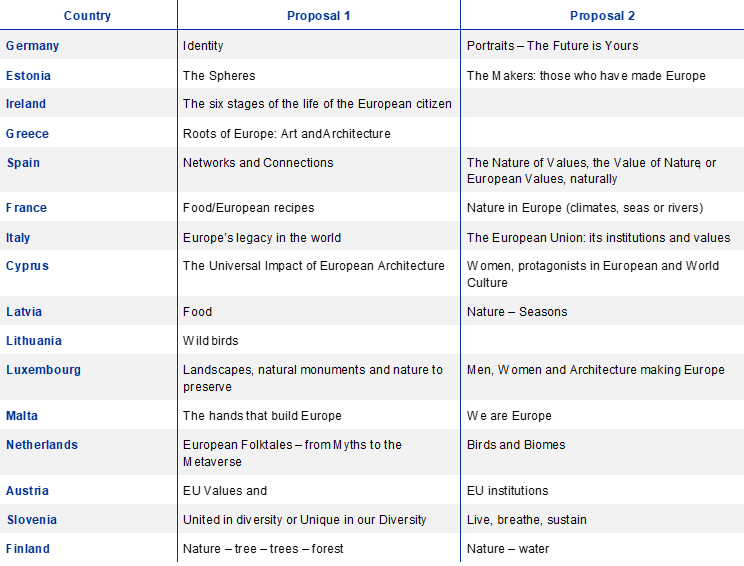
There are no proposals from Portugal and Belgium, as their members stepped down from TAG. Given the advanced stage of the process, it was agreed not to seek replacements for these members. For other reasons, no proposals were submitted by the member from Slovakia.
7 TAG suggestions for the design guidelines
TAG members also suggested some ideas for the design guidelines in the next step of the redesign process.
- All the banknotes could fit together in such a way that when the six banknotes are arranged next to each other, the individual designs connect to make one larger image, for example:
- a handshake extending across the six banknotes;
- the circle of stars across the six banknotes.
- While there were different views on this idea, it was suggested that each side of the banknotes could have a different purpose. For instance, the front would be the more “creative” side featuring the theme, and the back would be the more “practical” side containing some of the common design elements.
- The future banknotes could have a digital dimension, using different techniques, such as augmented reality, to allow the public to learn more about the banknotes. Augmented reality is already used in other banknotes[3].
- Some of the security features, such as iridescence and holograms, could be used to show dimensionality and movement.
- Common design elements to be included:
- The issuer (ECB), and the acronym in all languages
- The year of first issuance
- Signature
- Map of Europe, without political borders
- Flag and/or circle of stars
Annexes
List of TAG members
Lisa Borgenheimer
Germany, Professor of Information Design, HfG Offenbach am Main.
Lisa Borgenheimer has professional experience as information designer at Süddeutsche Zeitung and ZEIT Online, among others, and has worked internationally as a lecturer and freelancer. Borgenheimer holds a master’s degree in interactive media systems from the Hochschule Augsburg and is currently pursuing a doctorate at Bauhaus University Weimar.
Toomas Kiho
Estonia, Editor-in-chief, Akadeemia.
Toomas Kiho is the Editor-in-chief of Akadeemia. Between 2016 and 2020 he was the Head of the Steering Committee of Estonia 100. Previously he acted as Counsellor to the Prime Minister of Estonia and Counsellor to the President of Estonia. Kiho holds a PhD in mathematics from the University of Tartu, Estonia.
Fintan O’Toole
Ireland, Professor in Irish Letters, Princeton University, and columnist at The Irish Times.
Fintan O’Toole has published over 20 books on cultural and political history, including “A History of Ireland in 100 Objects”, “Heroic Failure: Brexit and the Politics of Pain” and most recently “We Don’t Know Ourselves: A Personal History of Modern Ireland”. He has has won both the Orwell Prize and the European Press Prize for his journalism. He is a member of the Royal Irish Academy.
Costas Varotsos
Greece, Artist and Professor, Faculty of Architecture, Aristotle University of Thessaloniki.
Costas Varotsos was elected as a Professor in the Architecture Faculty of the Polytechnic University of Thessaloniki in 1999. His art pieces can be found in public spaces in Greece, Cyprus, Italy, Switzerland, Spain, Egypt and in the United States. In 2014 he was honoured by the President of the Italian Republic, being awarded the title of Cavaliere della Repubblica Italiana for his contribution to the Italian arts. In 2017 he was honoured with the medal of the Brigadier of the Battalion of Honour from the President of the Hellenic Republic.
Nuria Oliver
Spain, Director and Co-founder, ELLIS Alicante Unit, and Chief Data Scientist, DataPop Alliance.
Nuria Oliver has over 25 years of research experience in human behaviour modelling and prediction from data and human-computer interaction. Oliver holds a PhD in artificial intelligence from the Massachusetts Institute of Technology and a degree in telecommunication engineering from the Technical University of Madrid.
Stéphane Distinguin
France, Founder and CEO, Fabernovel.
Stéphane Distinguin, a French entrepreneur and European tech and creative industries activist, founded the international innovation agency Fabernovel in 2003 after graduating from ESCP with a master’s in management. He also chairs the Grande École du Numérique, training over 10,000 young people every year to find a job in the digital economy.
Fabio Beltram
Italy, Professor of Physics of Matter, Scuola Normale Superiore, Pisa.
Fabio Beltram holds doctor’s degrees in physics and in electronic engineering and has carried out research and taught in the United States, France, and Italy. He is active in the field of nanotechnology, from electronics to biomedicine.
Demetrios Michaelides
Cyprus, Professor Emeritus of Classical Archaeology, University of Cyprus.
Demetrios Michaelides has professional experience in archaeology and the history of art, acquired during his time with the Department of Antiquities of Cyprus and the University of Cyprus. Michaelides holds a PhD from the University of London.
Ieva Zībārte
Latvia, Head of Exhibitions, Zuzeum Art Centre.
Ieva Zībārte is an award-winning architect, writer and curator. Currently Head of Exhibitions at Zuzeum Art Centre in Riga, she is also a member of the National Architecture Board at the Ministry of Culture and the Coin Design Committee at the Bank of Latvia.
Marija Marcelionytė-Paliukė
Lithuania, Professor, Vilnius Academy of Arts.
Marija Marcelionytė-Paliukė obtained a master’s degree in graphic arts from the Vilnius Academy of Arts in 2001. She has taught at the Academy since 2007 and has acted as Head the Graphic Art Department since 2014. Marcelionytė-Paliukė has more than 25 years of professional experience in arts.
Patrick Sanavia
Luxembourg, Director, Luxembourg National Heritage Office.
Patrick Sanavia graduated from the Robert Schuman University (Strasbourg) with a master’s degree in law. He practised as a lawyer and worked as counsellor of legal affairs for the Ministry of Culture. Since September 2008 Sanavia has worked as the director of the Luxembourg National Heritage Office, whose mission is to preserve the built heritage of the Luxembourg State.
Emanuel Buttigieg
Malta, Associate Professor in Early Modern History, Department of History, Faculty of Arts, University of Malta.
Emanuel Buttigieg is an Associate Professor in early modern history at the University of Malta. He read for his PhD at the University of Cambridge and is an expert on the Knights of Malta (the Knights of St John/the Hospitallers). He is also interested in the history of gender, slavery and rituals.
Alice Twemlow
Netherlands, Professor of History, Theory and Sociology of Graphic Design and Visual Culture, University of Amsterdam.
Alice Twemlow is a design historian and critic, with three decades of experience in research and education at institutions including the University of Amsterdam, Leiden University and the Royal Academy of Art, The Hague. She earned her master’s and PhD in history of design from the Royal College of Art/V&A Museum, London.
Peter Aufreiter
Austria, General Director and Scientific Managing Director, Vienna Museum of Science and Technology.
Peter Aufreiter is a cultural manager with 20 years of experience in various museums in Austria and Italy. He has been the Director General of the Austrian Federal Museum of Technology since January 2020. Aufreiter holds a master’s degree from the Faculty of Philosophy of the University of Vienna.
Jana Arbeiter
Slovenia, Assistant Professor and Researcher, Faculty of Social Sciences, University of Ljubljana.
Jana Arbeiter holds a PhD in diplomacy and is an Assistant Professor and Researcher at the Centre of International Relations (Faculty of Social Sciences, University of Ljubljana). Her research and teaching focuses on diplomatic theory, diplomatic protocol, symbolism and theory of symbolic power, and development studies.
Silvia Miháliková
Slovakia, Professor and Researcher, Slovak Academy of Sciences, Institute for Sociology, Trnava University.
Silvia Miháliková has professional experience in university education and social science research in the field of political science and sociology, acquired at universities and research institutions in Slovakia and abroad. Miháliková is a Professor of Political Science.
Maaria Wirkkala
Finland, Artist.
Maaria Wirkkala creates moments and places mostly outside of traditional art spaces. Her exhibitions include many major group exhibitions, including Venice Bienniale, Istanbul Biennial and several art festivals in Japan. She was the first laureate of the prestigious Ars Fennica prize.
Members from Portugal and Belgium who withdrew from the process:
Stephan Vanfleteren
Belgium, Photographer.
Stephan Vanfleteren is a world-renowned photographer who has worked as a photojournalist for the Belgian newspaper De Morgen and the Dutch newspaper De Volkskrant. He works almost exclusively in black and white. He covered important news events in the 1990s (current affairs, wars, etc.) and has continued to be featured in many newspapers and magazines worldwide ever since. He is also a visiting professor at the Royal Academy of Fine Arts in Ghent. Vanfleteren has won many international awards and he is Doctor Honoris Causa of the Free University of Brussels.
Elvira Maria Correia Fortunato
Portugal, Vice-Rector, NOVA University of Lisbon.
Elvira Maria Correia Fortunato pioneered research on transparent/paper electronics. She won two grants from the European Research Council related to oxide electronics. Fortunato is an elected member of Academy of Engineering, European Academy of Sciences, Lisbon Academy of Sciences and Academia Europaea. She was formerly Chief Scientific Adviser at the European Commission.
Theme proposals
Germany
Proposal 1

Proposal 2
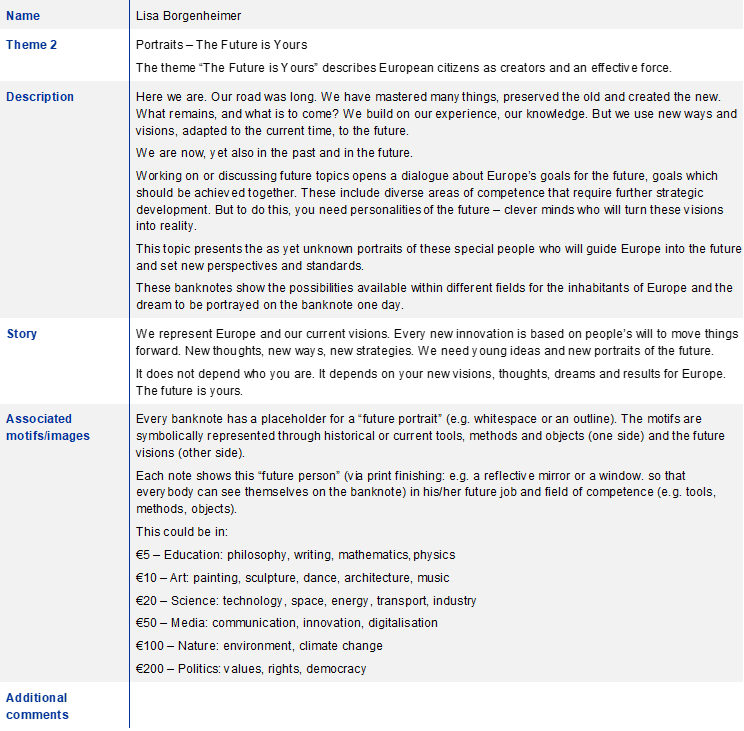
Estonia
Proposal 1
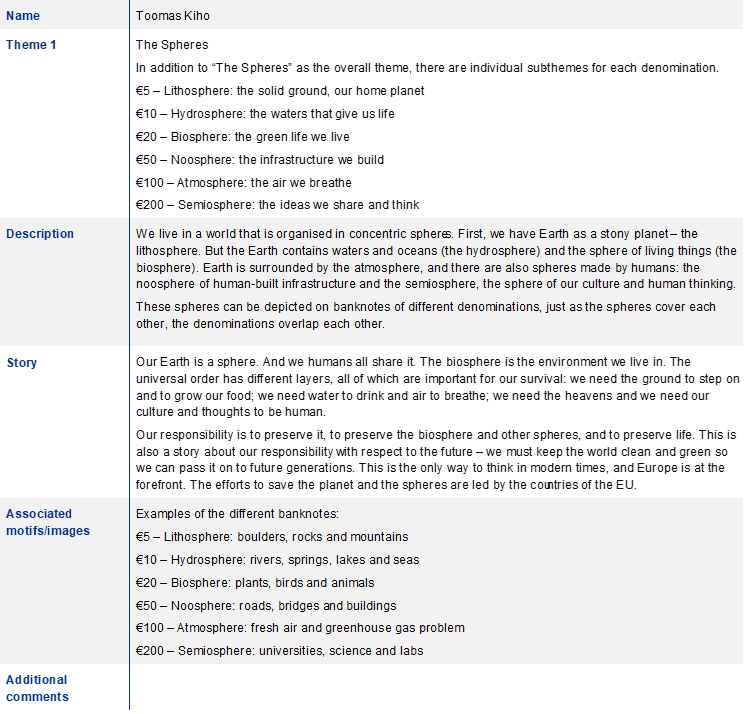
Proposal 2
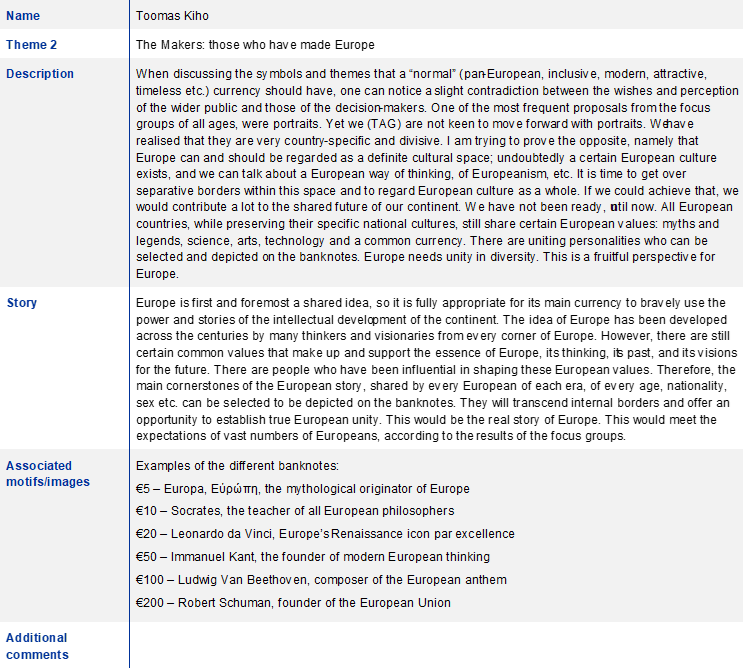
Ireland
Proposal 1
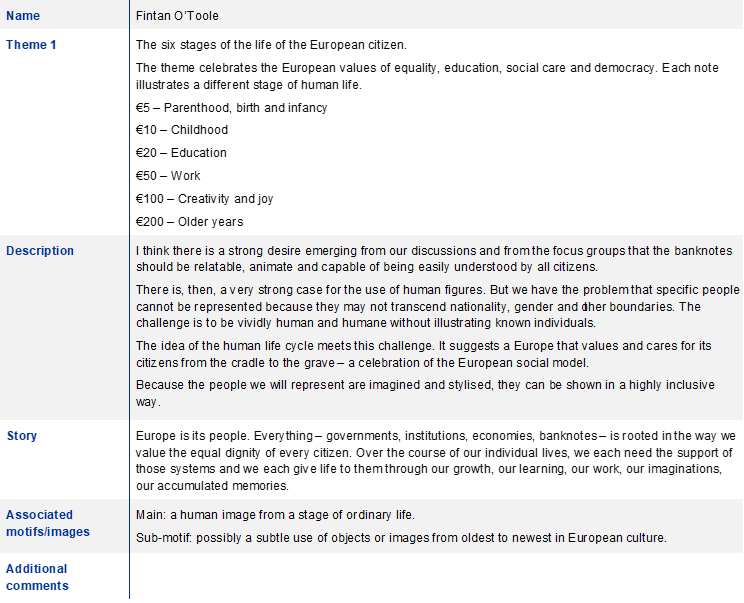
Greece
Proposal 1

Spain
Proposal 1
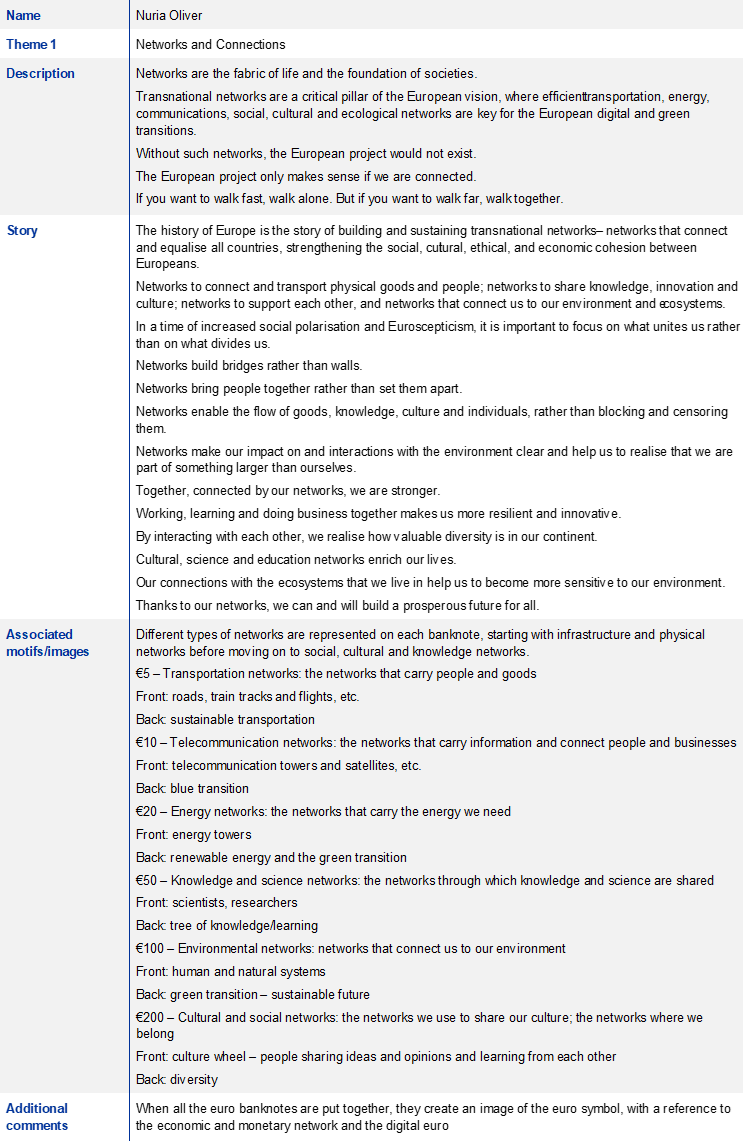
Proposal 2
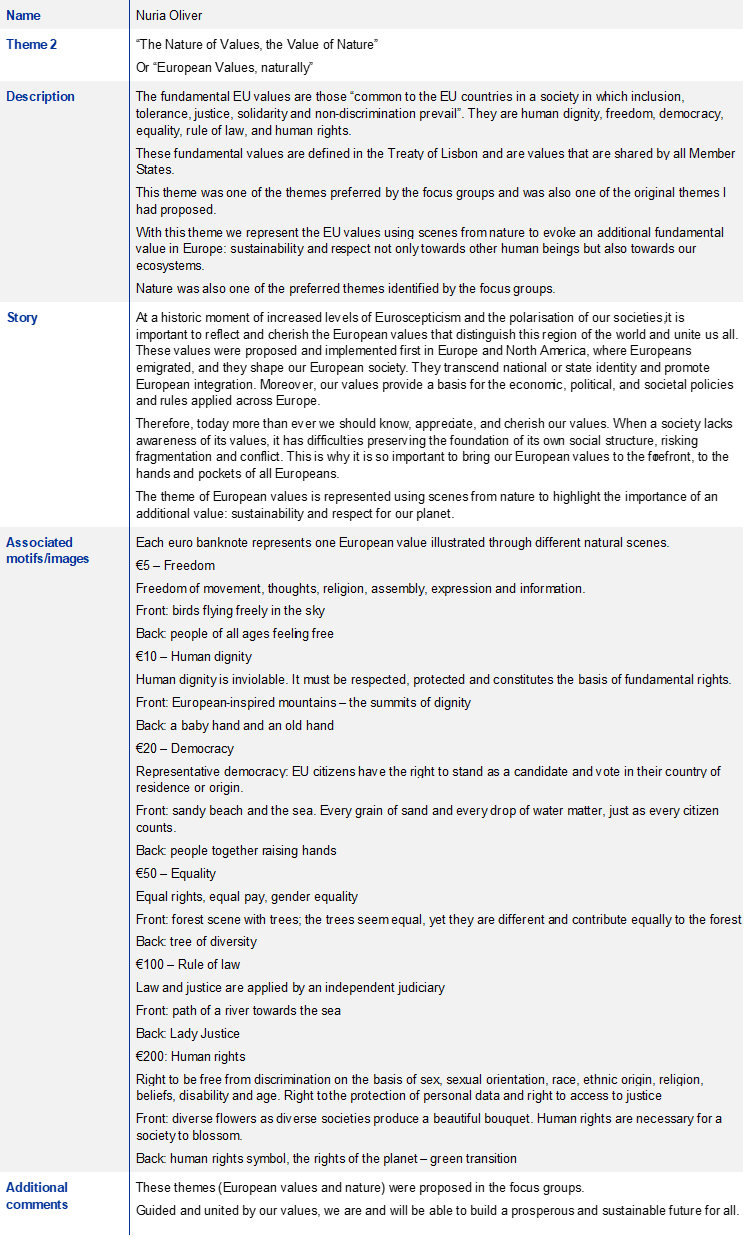
France
Proposal 1
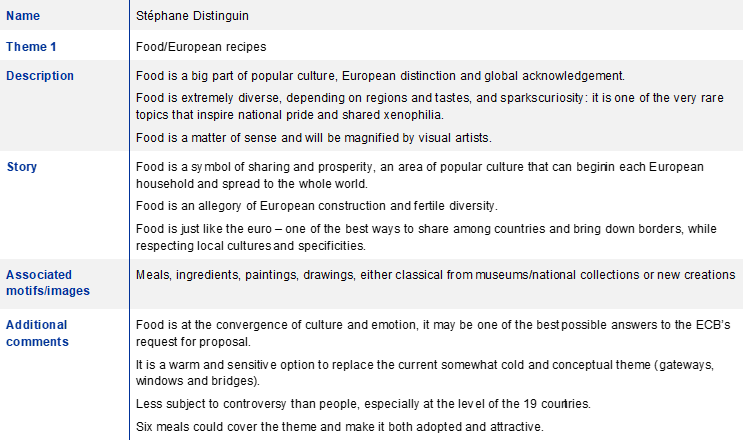
Proposal 2
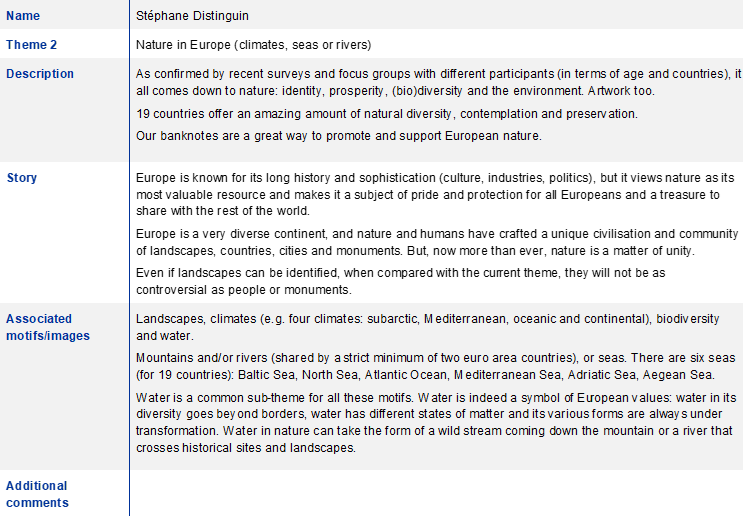
Italy
Proposal 1
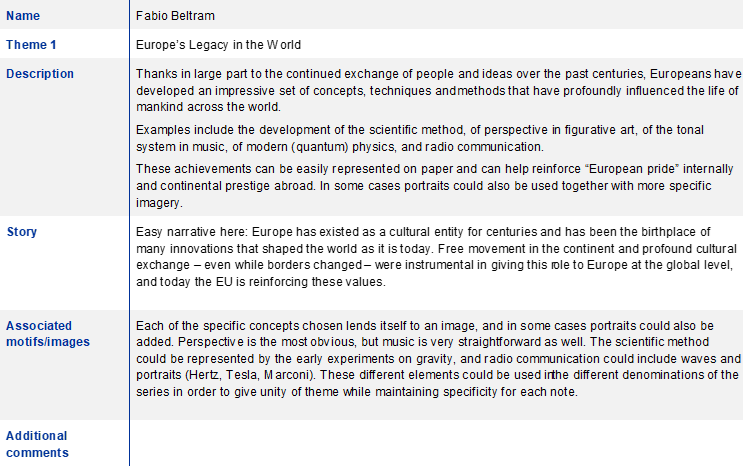
Proposal 2
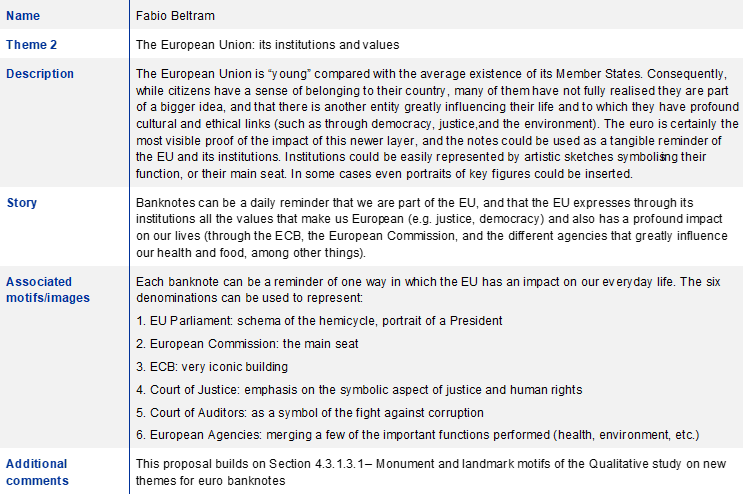
Cyprus
Proposal 1
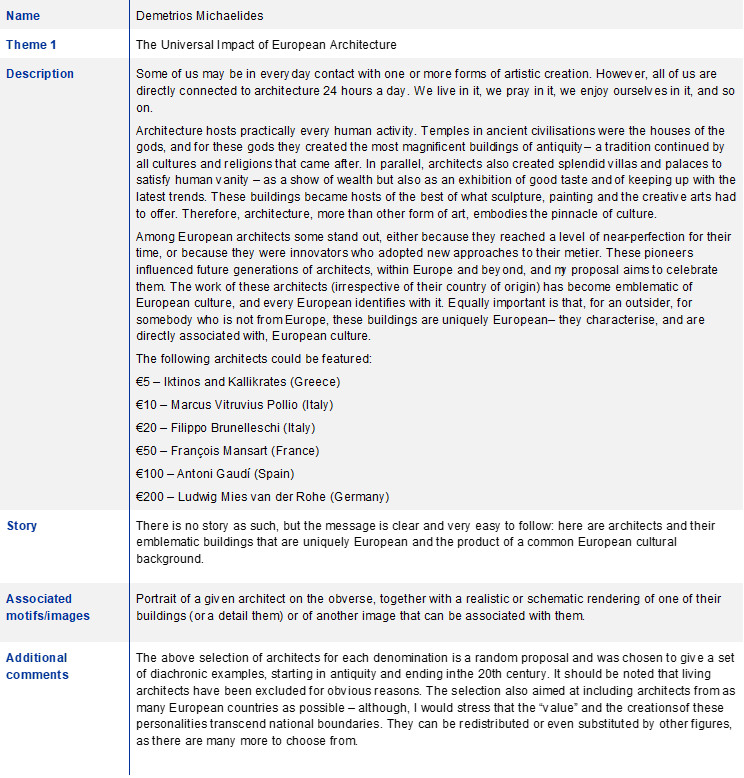
Proposal 2

Latvia
Proposal 1
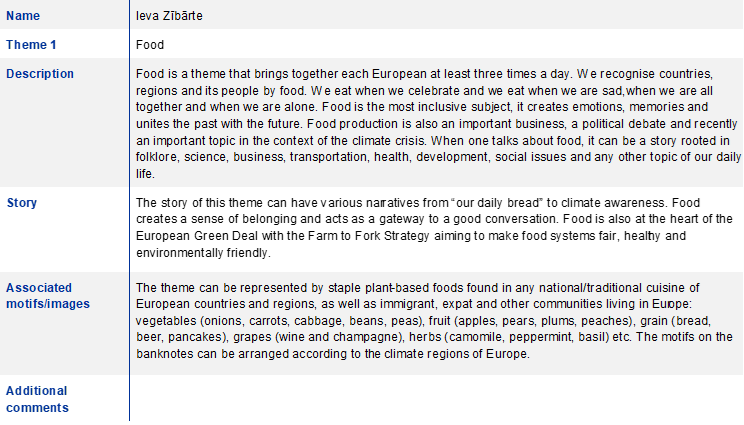
Proposal 2
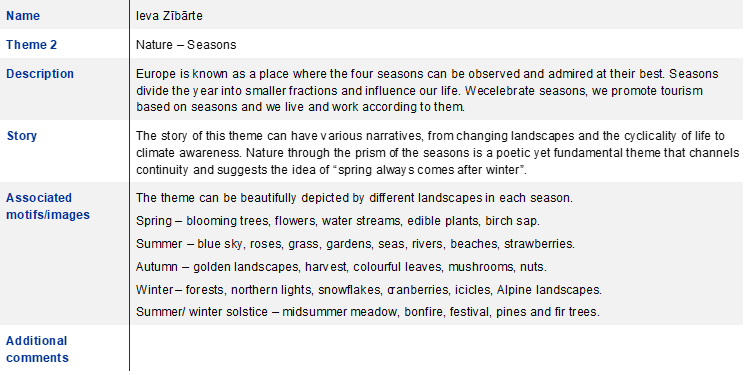
Lithuania
Proposal 1
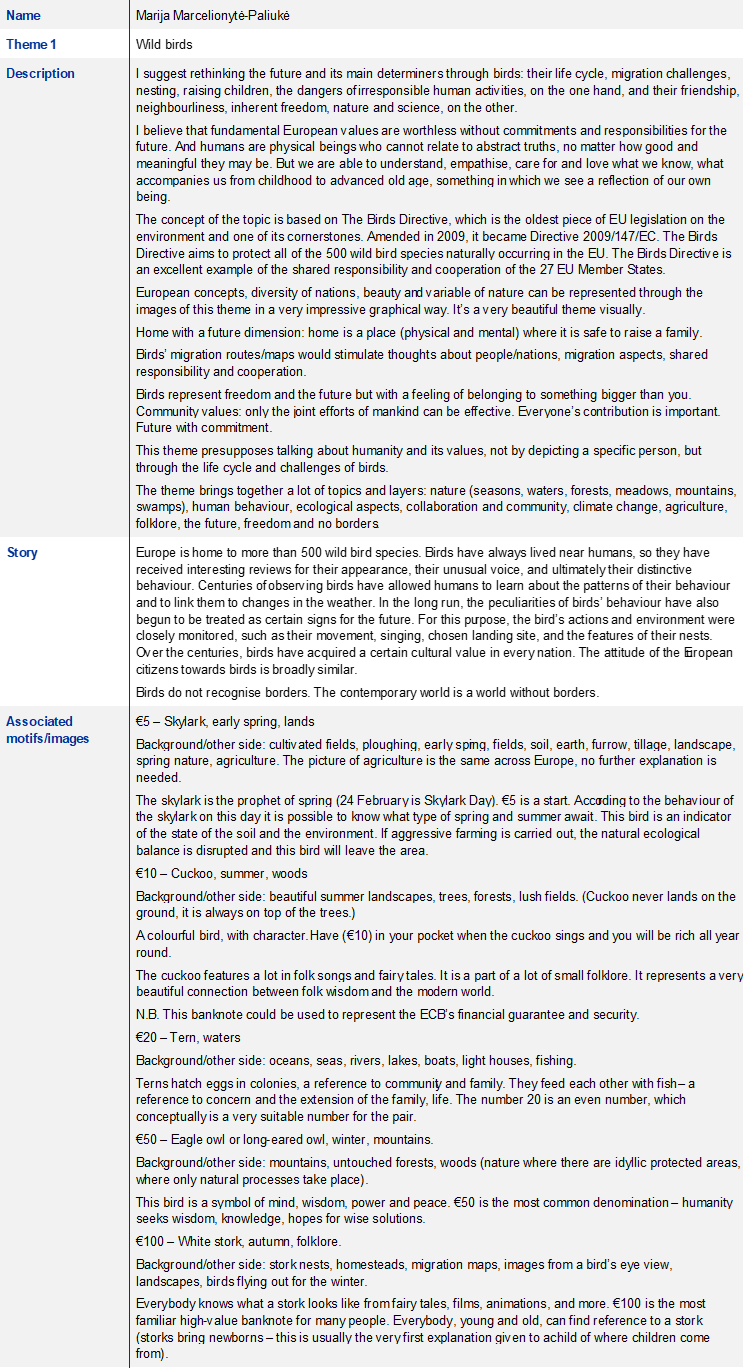
Luxembourg
Proposal 1
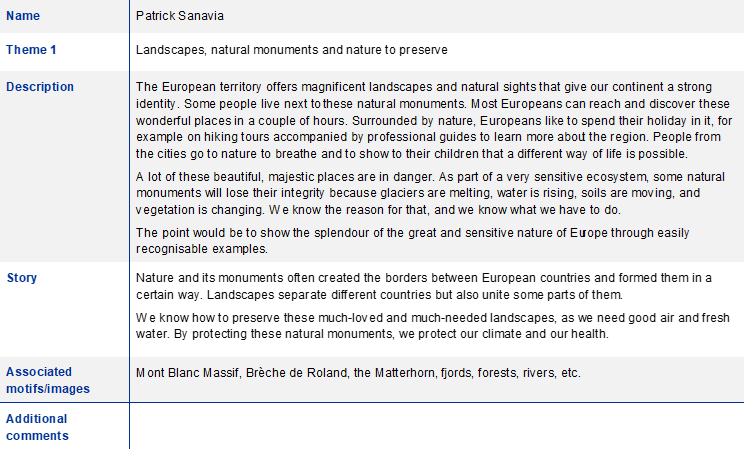
Proposal 2
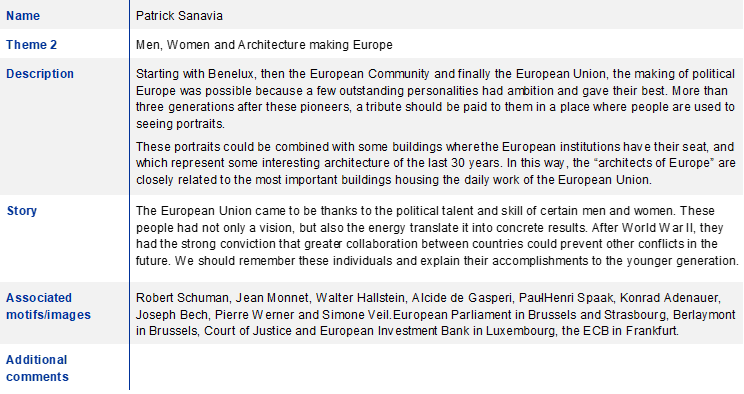
Malta
Proposal 1
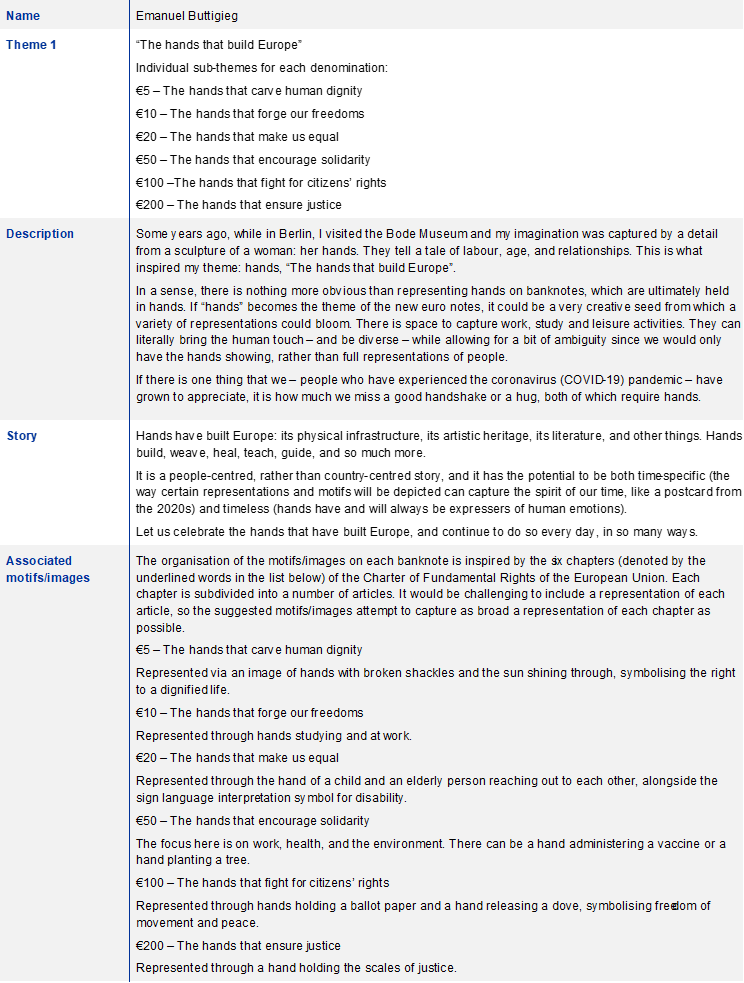
Proposal 2

Netherlands
Proposal 1
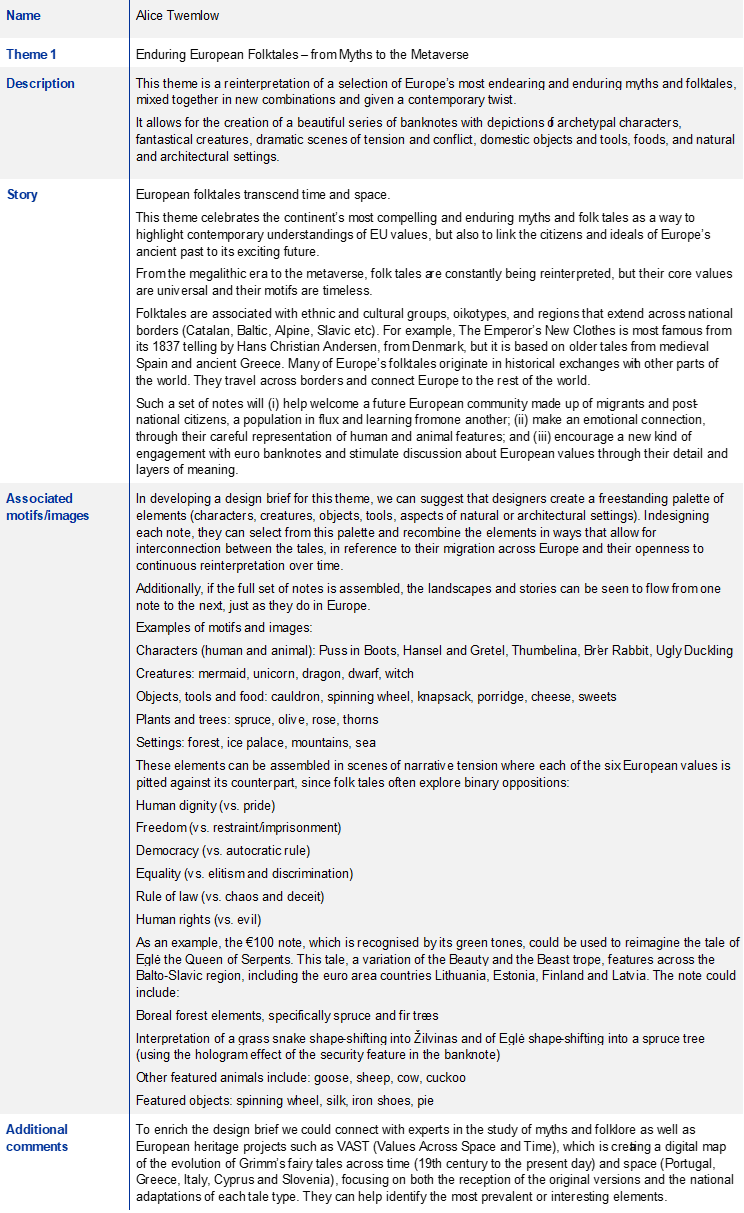
Proposal 2

Austria
Proposal 1
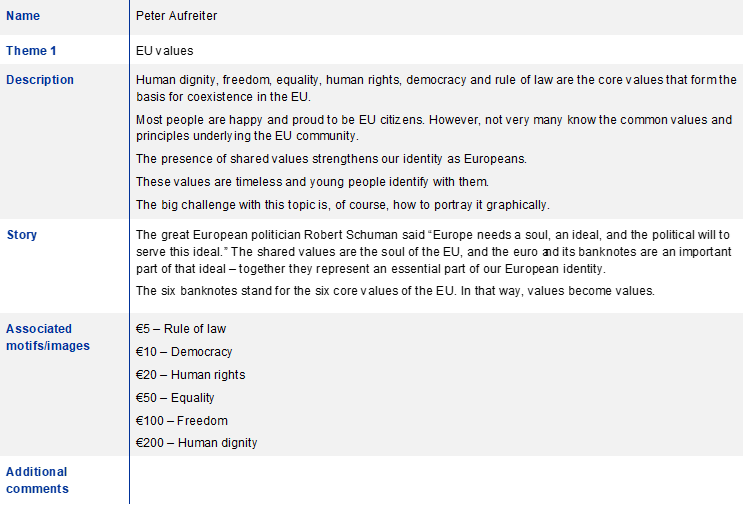
Proposal 2
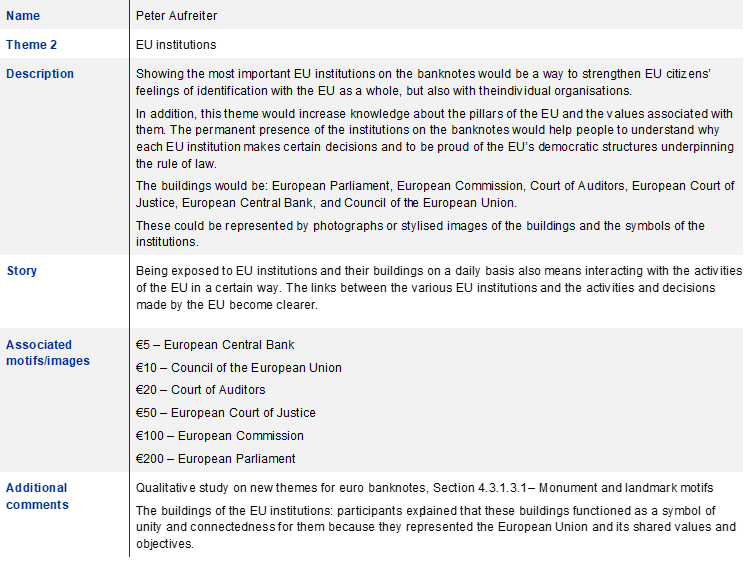
Slovenia
Proposal 1
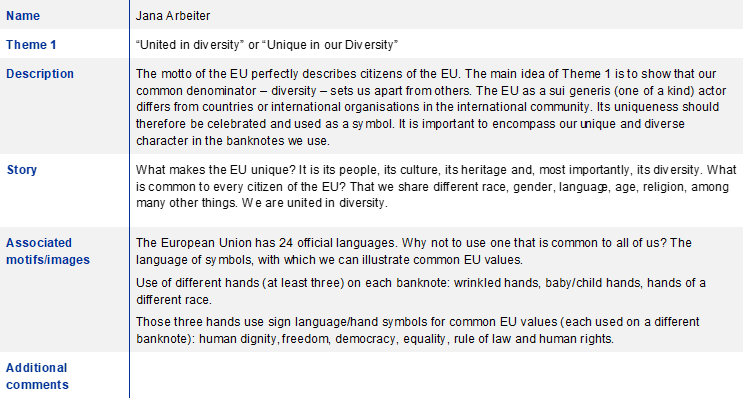
Proposal 2
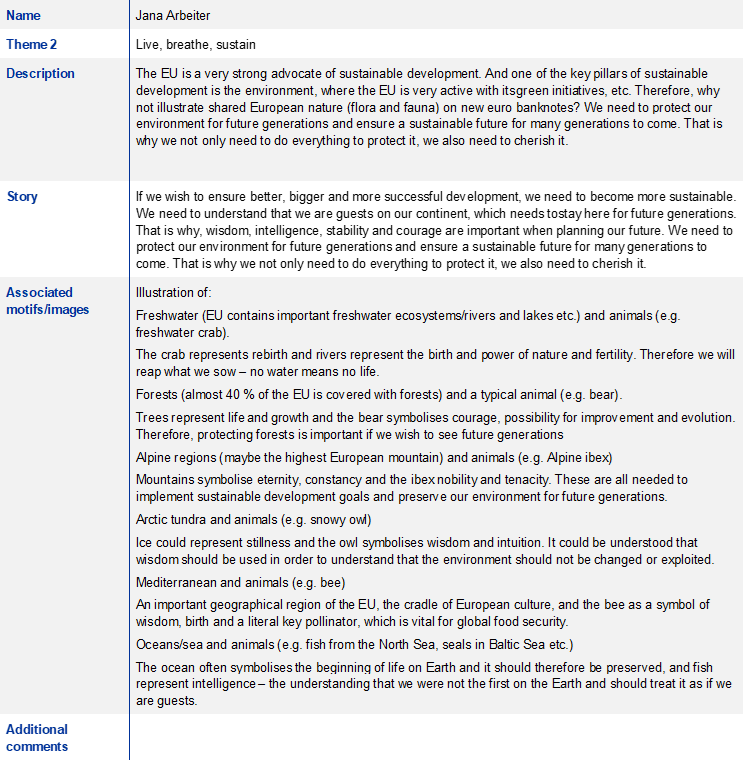
Finland
Proposal 1

Proposal 2
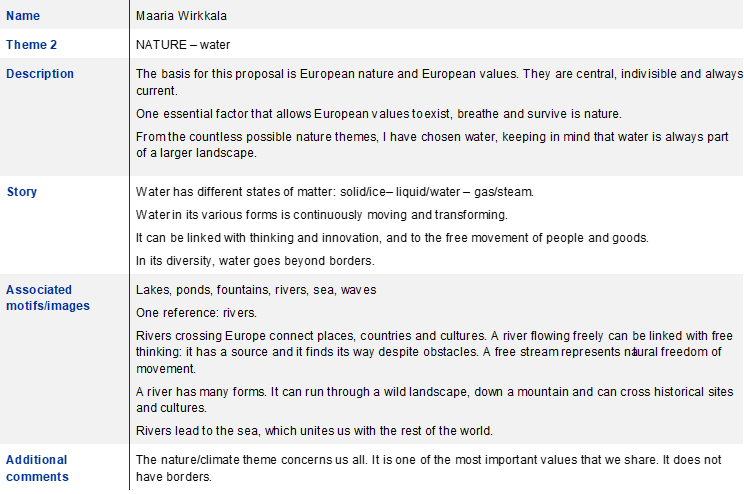
Qualitative study on new themes for euro banknotes
© European Central Bank, 2023
Postal address 60640 Frankfurt am Main, Germany
Telephone +49 69 1344 0
Website www.ecb.europa.eu
All rights reserved. Reproduction for educational and non-commercial purposes is permitted provided that the source is acknowledged.
For specific terminology please refer to the ECB glossary (available in English only).
PDF ISBN 978-92-899-6160-8, doi:10.2866/911190, QB-03-23-312-EN-N
HTML ISBN 978-92-899-6159-2, doi:10.2866/228562, QB-03-23-312-EN-Q
ECB, “Qualitative study on new themes for euro banknotes”, 2022.
Common design elements are images or symbols that are unrelated to the theme but are present for practical purposes and to express European identity.
Augmented reality has been used in banknotes issued by the Central Bank of Honduras (see YouTube video) and the Bank of Mexico (see Tweet).


